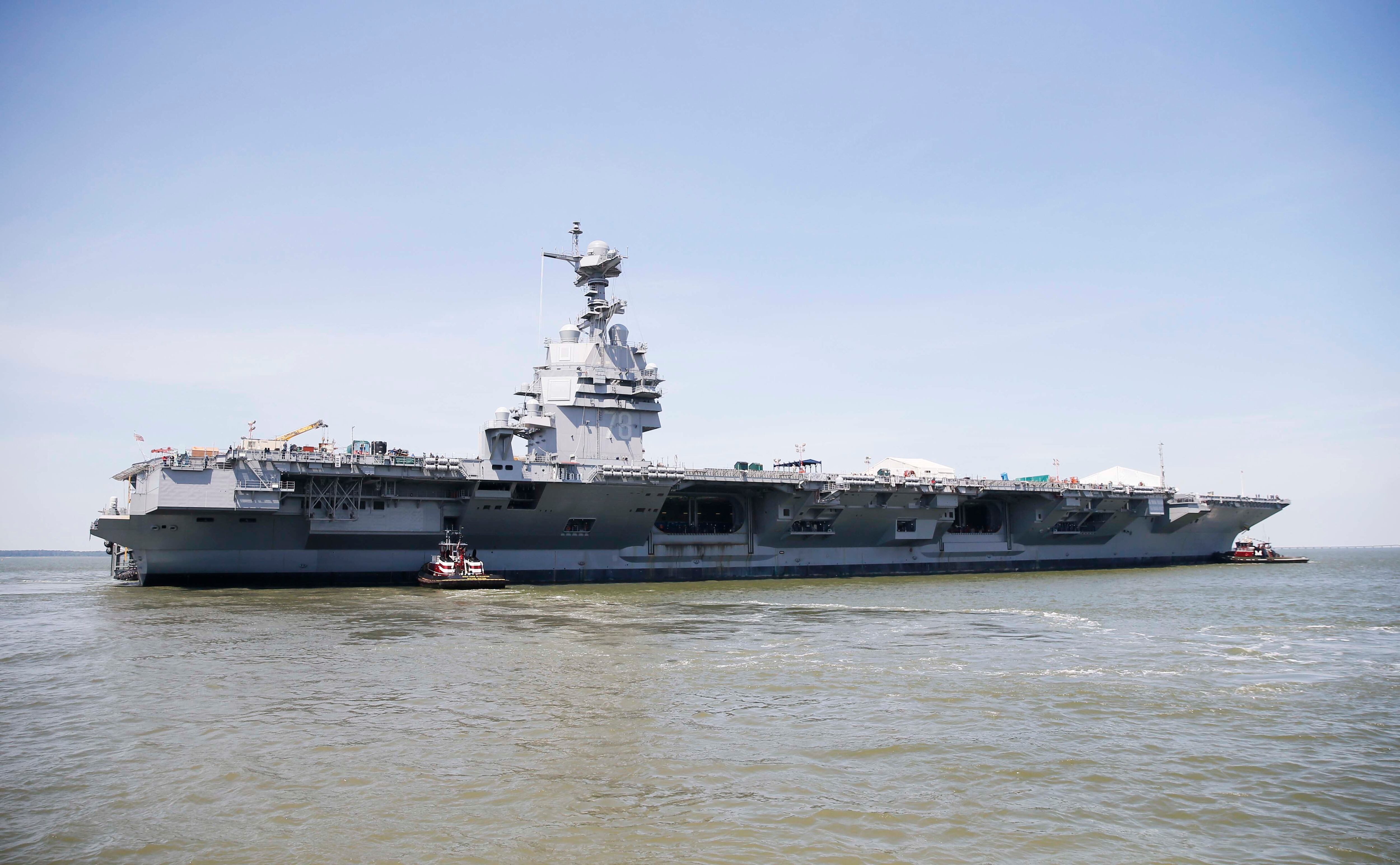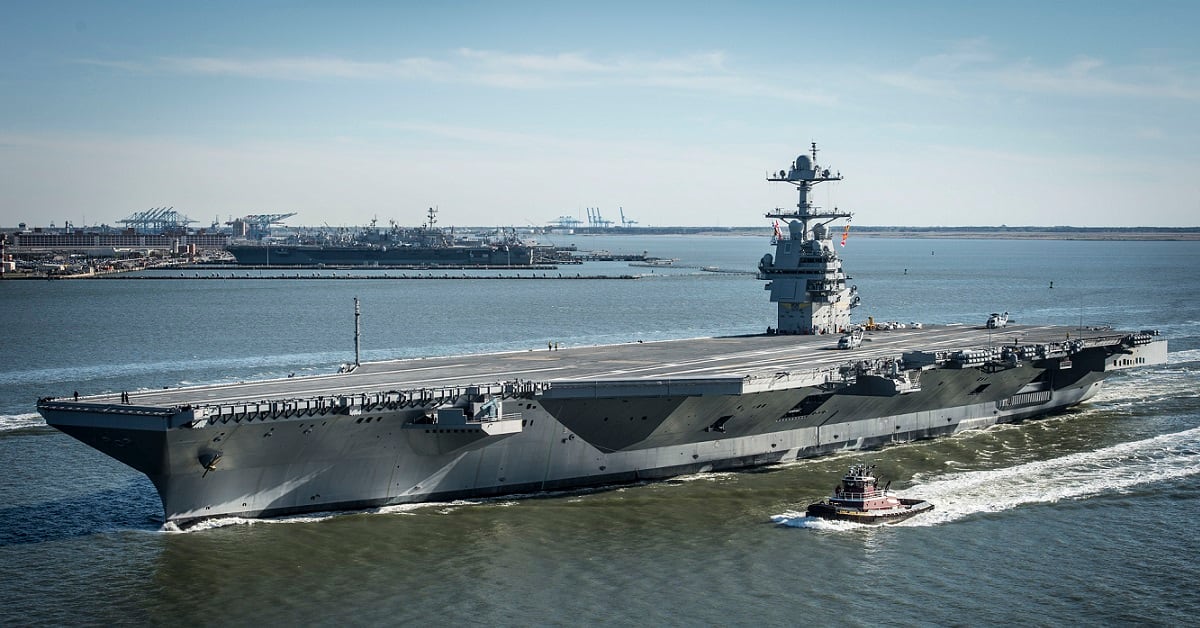NORFOLK, Va. ― Yet another propulsion train problem has forced the Navy’s newest aircraft carrier, the Gerald R. Ford, back into port for “adjustments” before it can get back underway to complete what had been expected to be a long testing period.
“The ship experienced a propulsion system issue associated with a recent design change, requiring a return to homeport for adjustments before resuming at sea testing,” said Colleen O’Rourke, spokeswoman for Naval Sea Systems Command in Washington.
The ship left Norfolk early May 19 for what sources tell Navy Times was to be an extended period underway, slated to be the ship’s last sea time before entering its scheduled post-shakedown availability maintenance period at Huntington Ingalls Newport News shipyard this summer.
RELATED

That yard period, known as a PSA, is expected to fix a laundry list of issues that have popped up in the past year onboard the first new carrier design the U.S. has fielded in 40 years.
Navy officials don’t know how long the current needed adjustments will take that caused the ship to abort its underway period. For security reasons, the Navy doesn’t normally discuss ship’s schedules, but the anticipation is that the ship will return to sea soon to resume testing.
“Ford has been tasked with conducting critical test and evaluation operations that identify construction and design issues,” O’Rourke said “As a continuation of that testing and evaluation process, Ford got underway to conduct an independent steaming event that would allow the ship and its crew to continue testing its systems and procedures.”
Navy officials say the issue isn’t with either of the ship’s two reactors.
RELATED

Rather, the issues reside in the mechanical components associated in turning steam created by the nuclear plant into spinning screws that power the ship through the water. These include steam turbines, reduction gear, shafts and screws.
Details on exactly what in that drivetrain was redesigned and needs adjustment has not been released, though officials did say that this latest issue is unrelated to another propulsion-related issue that popped up earlier this year.
“During at-sea testing in January, the crew identified one component in the propulsion train was operating outside of design specifications and took action to place the propulsion train in a safe condition,” Bill Couch spokesman for Naval Sea System told Navy Times. “This was the second issue identified in the propulsion train in the last year.”
A detailed inspection found that component, which some reports have described as a flawed bearing, was not built to design specifications.
“The Navy and Newport News Shipbuilding have determined the required steps to correct the manufacturing defect,” Couch said. “The defects will be fully corrected during PSA.”
The Navy and Newport News Shipbuilding, he said, are evaluating the case for a possible claim against the manufacturer.
“As a first-in-class ship, this is not unexpected,” O’Rourke said. “Some of the ship’s components are most effectively tested while the ship is underway during typical steaming conditions. Events like this prove that the testing and evaluation process works. Corrections will be made to USS Gerald R. Ford, and integrated into the next ships in the Ford carrier class.”
RELATED

However, recent government reports question the long-term reliability of the new electromagnetic catapults and advanced arresting gear, as well as the ship’s weapons elevators, again called into question as to whether all the new technology is ready for prime time ― or at least a wartime deployment.
This latest knock on the Ford came in a January 2018 report from the Department of Defense’s director of operational test and evaluation, which also called into question the long-term reliability of a number of other key systems onboard the Ford.
A senior Navy official familiar with the Ford’s design and growing pains acknowledged that the difficulties are real, but that the Navy had similar issues with new technologies on other first-in-class vessels, such as the guided-missile destroyer Arliegh Burke, and the amphibious transport dock San Antonio.
The official, who has worked on the Ford’s development, requested anonymity because he was not authorized to speak officially on these topics.
Both the Burke class and the San Antonio class ships, he said, brought new designs and technology, much of which took time to work out once the ships started to operate at sea.
“The record shows that the Burke and the San Antonio had similar issues and got less than passing grades from DTO&E and other inspections at the time,” the source said. “But somehow the issues have all been worked out over time and these ships and their classes have proven their reliability over time. The feeling in the Navy is that the Ford class will follow a similar path.”
Long-term effectiveness of the Burke class hasn’t been questioned in years, the Navy official said, and the San Antonio class ― after a lot of post delivery issues ― had developed into a darling of the Marine Corps. And Congress may now fund the building of yet another.
“Ford has proven out a lot of new systems and has the lowest number of deficiencies compared to the most recent new aircraft carrier,” O’Rourke said. That most recent new carrier is the George H.W. Bush.
Since being commissioned in July, NAVSEA’s Couch outlined some of Ford’s successes after spending “nearly 70 days at sea through six independent steaming events.
To date, he said, the ship has completed 747 shipboard aircraft launches and recoveries and has successfully completed fixed-wing aircraft and helicopter integration and compatibility testing.
Already certified are the air traffic control center and JP-5 fuel system. Other systems have completed initial demonstrations with out major issues such as daytime underway replenishment capability and ship’s defensive systems.
Also, software fixes are slated to fix issues with the electromagnetic aircraft launch system already in the works to significantly reduce excessive stress put on airframes in the original EMAL’s operating software that will be fixed in a 2019 upgrade.
“Events like this prove that the testing and evaluation process works,” O’Rourke said. “Corrections will be made to USS Gerald R. Ford, and integrated into the next ships in the Ford carrier class.”
Mark D. Faram is a former reporter for Navy Times. He was a senior writer covering personnel, cultural and historical issues. A nine-year active duty Navy veteran, Faram served from 1978 to 1987 as a Navy Diver and photographer.





